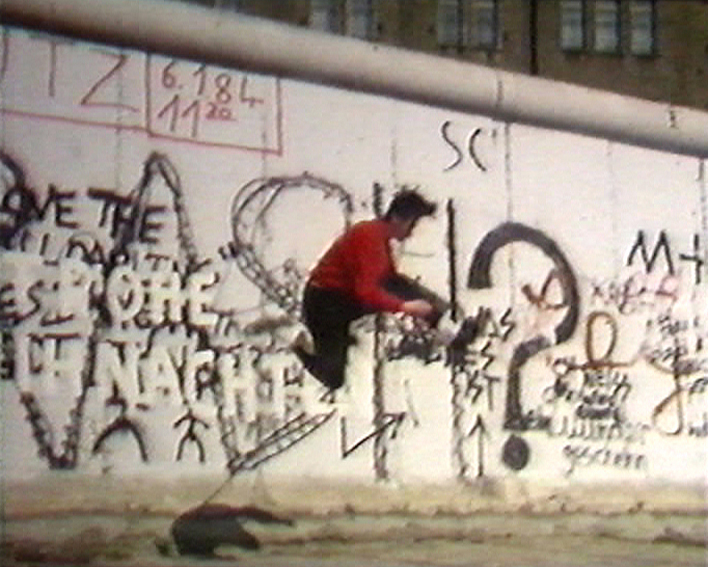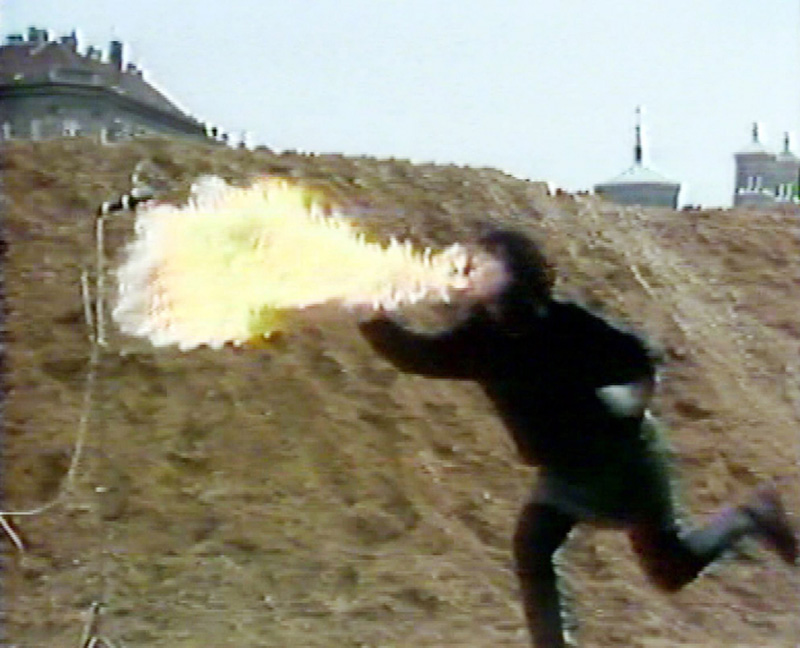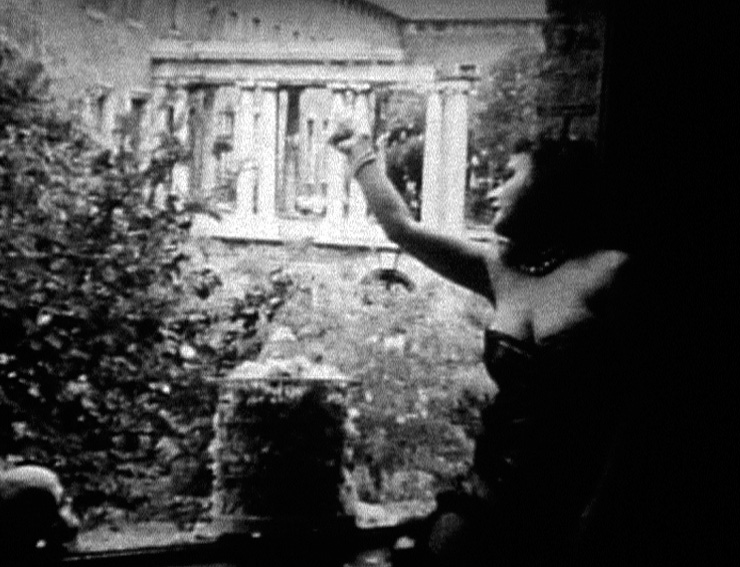Part of Fall 2008 - A Lower World
A co-presentation with Goethe-Institut Toronto
Between the end of the 1970s and the fall of the Berlin Wall in November 1989, a vast number of films were produced in and about West-Berlin, dealing with the ambivalent realities of the encapsulated city. Highly subsidized by the Federal Republic of Germany as a “shop window of the Free West”, West-Berlin had become an island, an inverted fortress for all those who saught to experience themselves without economical pressures, and to express themselves by all means. It wasn’t about devoting oneself to the World Revolution anymore, but to implement alternative life styles and ways of housing, giving rise to social resistance, strident underground cultures and sexual border-crossing. Pessimism and apocalyptic moods, not least driven by the enhanced arms race and nuclear threats of the period, mixed with extravagance, punk and queerness.
Where images lived a special life inmidst the deadlock of socialist and capitalist ideologies that nowhere else materialized as spectacular as in the divided city of Berlin, an idiosyncratic crossover of music, performance, art and Super-8 movement developed. For many young filmmakers, Super-8 facilitated the production of low cost and truly independent films. The technical limitations of the medium embodied a strong means of spontaneity and purposeful dilettantism, while Super-8 was easy to distribute and show in off-cinemas, clubs and cafes. Even institutions like the German Film and Television Academy in Berlin (dffb) fostered a spirit of radical subjectivity and experimentation among students.
The extraordinary activity of the various groups and individuals working with film and video in West-Berlin in the 1980s was subject to an extensive retrospective in October 2006 at Kino Arsenal, Berlin, entitled Who says that concrete doesn’t burn? Did you try? The series comprised all kinds of film genres, from experimental films and video art to documentary and fiction, and covered a multiplicity of issues. For Pleasure Dome, the curators of the series, Stefanie Schulte Strathaus and Florian Wüst, selected two short film programs and a feature-length music film that cast light on this unique, yet partly forgotten historical period and urban site of German film production.
The first short film program, Under Siege, with works by Jürgen Baldiga, Cynthia Beatt, Brigitte Bühler & Dieter Hormel, Andrea Hillen and Rolf S. Wolkenstein, depicts feelings of difference and longing. The violent history of the city presents itself inscribed in sooted ruins and post-war architecture, as well as in the reserved mind-set of its native residents. The fragmentation of fictional narrative, stylised atmospheres and collage techniques reflect the experience of uneasiness that is turned into strong artistic expression. Expanding on similar aesthetic strategies, Night Souls, the second short film program of the triple feature, addresses the pathological condition of a rationalized and militarized world, and meets it with ecstasy, irony and the grotesque. The films of Klaus Beyer, Michael Brynntrup, Die Tödliche Doris, Christoph Doering, Ingrid Maye & Volker Rendschmidt, Lysanne Thibodeau and Yana Yo create a sensual journey into dark fantasy and colourful trash culture. OKAY OKAY. Der moderne Tanz, made by Christoph Dreher and Heiner Mühlenbrock in 1980, travels through post-apocalyptic landscapes and urban decay, interspersed with camera footage of live concerts and staged performances. The delicate choice of songs by Pere Ubu, Chrome, Ultravox, The Residents, Throbbing Gristle or Wire not only underscores the images, it rather builds the core of the oustanding film: a music that represents a distinct attitude and approach to contemporary life, profoundly influenced by Punk and New Wave.
Programme 1: Under Siege
a-b-city, Brigitte Bühler, Dieter Hormel, 1985, 8 min. Super-8 on video West Germany
Accompanied by a score using music of Pere Ubu and Einstürzende Neubauten, a-b-city revolves around West-Berlin’s psychodelic atmosphere. Brigitte Bühler and Dieter Hormel, who were renown for their fast paced and skillfully edited Super-8 clips, mix TV images and time-lapse shots of nightly streets, drifting clouds, and a men continuously jumping in front of the Berlin Wall, bringing about an impression of the enclosed city that constantly shifts between ecstasis and depression.
Böse zu sein ist auch ein Beweis von Gefühl, Cynthia Beatt, 1983, 25 min. 16mm, West Germany
Elduing easy categorisation, Cynthia Beatt’s Böse zu sein ist auch ein Beweis von Gefühl (Fury is a feeling too) is both a documentary on the city of Berlin and a semiautobiographical essay on alienation and being an alien in that city. Formally it is composed of a combination of jerky panning shots over the buildings near Potsdamer Platz while still being a wasteland, dramatised performances of angry social altercations, personal reflections and sombre elegaic music (written by Maurice Weddington). With her intellectually astute film, Beatt raises questions on a wide range of issues to do with language and culture, politics, history and architecture.
60cm über dem Erdboden, Andrea Hillen, 1984, 6 min. Super-8 on video, West Germany
The title, 60cm über dem Erdboden (60 centimeters over ground), describes a simple fact about making this film: Andrea Hillen put her Super-8 camera into the baby carriage while walking the streets of Berlin. It shows the world from the uncommon perspective of her child looking at the gloomy sky, at the tops of the surrounding houses, the withered branches of the trees or its mother rushing in and out of the frame. Complemented with an electronic soundtrack, the film creates a dark and uncanny atmosphere, true to the days of winter in the city.
Geld, Brigitte Bühler, Dieter Hormel, 1983, 4 min. Super-8 on video, West Germany
Evenb before music videos revolutionized the industry and MTV arrived in Germany, Geld (Money) was produced and released as a video clip for the all-female band Malaria!. Bühler and Hormel shot the band members around Gudrun Gut and Bettina Köster in an empty cellar. Streaks of light were projected onto the musician’s faces and androgynous looks, and refilmed on Super-8 so that they seemed to peek out from behind a layer of torn darkness. This low-tech effect combined with double exposure and cross fading creates a striking visualization of the nebulous lyrics of the song: “there is no clarity / there is no fog / ah, if I weren’t hungy / how happy would I be / our belief is our world / our belief is our money.”
Tattoo Suite, Rolf S. Wolkenstein, 1984, 23 min. 16mm, West Germany ,
During his studies at the German Film and Television Academy in Berlin (dffb), Rolf S. Wolkenstein sought for an unconventional film narrative that reflects the multiplicitiy of impressions and influences he encountered as a young man in the divided city. Consequently, Tattoo Suite, an experimental film for which Wolkenstein collaborated with a vast number of friends, colleagues, and fellow filmmakers, presents a cluster of staged performances that are only connected through surreal cuts and radical changes of scenery: a collection of moods and figures capitivited by discommunication and isolation.
Darum oder was erwartest Du?, Jürgen Baldiga, 1981, 7 min. Super-8 on video, West Germany
After moving to West-Berlin in 1979, Jürgen Baldiga started working as an autodidact in photography. Darum oder was erwartest Du? (That’s why or what do you expect?) is his only finished Super-8 film. In the silent short, shot in a single take, he sits and looks lasciviously, sometimes bored, at the camera. Reminiscent of Andy Warhol’s portrait films, Baldiga’s ambiguous performance challenges more the viewer’s expectations than revealing something of himself. Jürgen Baldiga died of AIDS in 1993; Michael Brynntrup paid tribute to him and his work in the film Aidé Memoire (1995).
Programme 2: Night Souls
Normalzustand, Yana Yo, 1981, 3 min. Super-8 on video, West Germany
Yana Yo’s short film Normalzustand (Normal Condition) is paced to the 1980 song Apokalypse of Fehlfarben, a lengendary West German punk rock band. In synch with the hard rhythm as well as the content of the music, Yo edits a collage of military tanks, air planes, super market shelves, rotating reels of magentic tape for data storage, and a burning plastic dummy. Both, images and music, comment on the dehumanizing effects of the modern economical world as well as on the arms race mania of the Cold War.
Bad Blood for the Vampyr, Lysanne Thibodeau, 1984, 22 min. 16mm, West Germany/Canada
For most of the 1980s, Montréal-based filmmaker Lysanne Thibodeau lived in Berlin. Inspired by the post-punk decadence of the city, she made Bad Blood for the Vampyr, starring Blixa Bargeld, Gudrun Gut, Oliver Shunt, and Norbert Hähnel (alias Der wahre Heino). This jewel of a cult film tells the gothic story of a lonesome vampyr who is sick of life while strolling through the modern city in search for virgin blood. But the quality of blood isn’t what it once was, and real virgins aren’t available anymore either.
Ohne Liebe gibt es keinen Tod, Ingrid Maye, Volker Rendschmidt, 1980, 5 min. Super-8 on video, West Germany
Ohne Liebe gibt es keinen Tod (Without Love There Is No Death) is a film about love and the interconnectedness of dream and reality. The artificial and surreal mood of the scenery is enhanced by coloured camera filters and spot lights, and supplemented by self-made electronic music. It was shot in the filmmakers’ own apartment – as so many Super-8 films of the time revolving around personal spaces – and cut in one go without any subsequent editing.
Persona Non Grata, Christoph Doering, 1981, 16 min. Super-8 on video, West Germany
The world at war runs over a TV screen in an empty space. While the light sets over the city, a young man eventually takes the TV and throws it out of the window. This is the moment for him to head out into the dark, ecstatic jungle of the night, with punk music, drugs and wild drives over the city’s highway. The films of Christoph Doering, who was member of the artist group Notorische Reflexe, are key to West-Berlin’s notorious Super-8 avant-garde of the early 1980s.
Kreuzberger Frauen, Klaus Beyer, 1983, 3 min. Super-8 on video, West Germany
Klaus Beyer is candlemaker by profession. His real life though starts after work, when he writes texts, makes music, and edits movies. He mostly performs himself in front of the Super-8 camera in his one room apartment or sings badly in public. Following the motto “Do-it-yourself is beautiful”, Beyer created a film ouevre of fascinating naivity and oustanding trash aesthetics. With his gorgeously funny short Kreuzberger Frauen (Kreuzberg Women), he appropriates the 1978 popular song and German number one hit Kreuzberger Nächte (Kreuzberg Nights) of the Blattschuß Brothers.
Die Botschaft (Totentanz 8 ), Michael Brynntrup, 1989, 10 min. 16mm, West Germany
Michael Brynntrup’s cycle Totentänze (Dances Of Death) centers around an actor or performance artist. In Die Botschaft (The Message) it is Valerie Caris-Ruhnke who moves through the abondoned ruins of the Italian Embassy in Berlin, while throwing about herself downy feathers taken from the cage of the horn of plenty. Finally she sits on a balustrade with the cage of feathers between herself and a skull. The end of the film shows an erotic encounter, a French kiss with death.
Naturkatastrophenkonzert, Die Tödliche Doris,1983, 3 min. video, West Germany
On a sand heap in front of the Berlin Wall, Die Tödliche Doris stages their Naturkatastrophenkonzert (Concert Of Natural Disasters), shot on video for West German TV: after the microphone has been set on fire, short musical pieces are played in an overly amateurish fashion. The group around Wolfgang Müller, Käthe Kruse and Nikolaus Utermöhlen existed from 1980–87, and represented one of West-Berlin’s most idiosyncratic artistic formations that mixed music, art, performance, and film.
Programme 3: OKAY OKAY. Der moderne Tanz
OKAY OKAY. Der moderne Tanz, Christoph Dreher, Heiner Mühlenbrock, 1980, 90 min. 16mm, West Germany
Produced at the German Film and Television Academy in Berlin (dffb), OKAY OKAY. Der moderne Tanz (OKAY OKAY. The modern dance) is a music film in its best sense: a timeless selection of punk, post-punk and new wave songs (amongst others Pere Ubu, Throbbing Gristle, Wire, The Red Crayola) greatly defines the mood and rhythm of the film. With each new title, Christoph Dreher and Heiner Mühlenbrock introduce a new situation or locality, mostly comprising fragments of a men made world empty of people: waste sites, park garages, industrial chimneys, and run down housing blocks. From these post-apocalyptic landscapes both, the music and film, draw their energy and living resistance.
Further screenings of Screaming City: West-Berlin 1980s will be held at La Sala Rosa in Montréal, in collaboration with Double Negative and Articule, and at Available Light Screening Collective in Ottawa.
Presented with the support of Goethe-Institut Toronto




